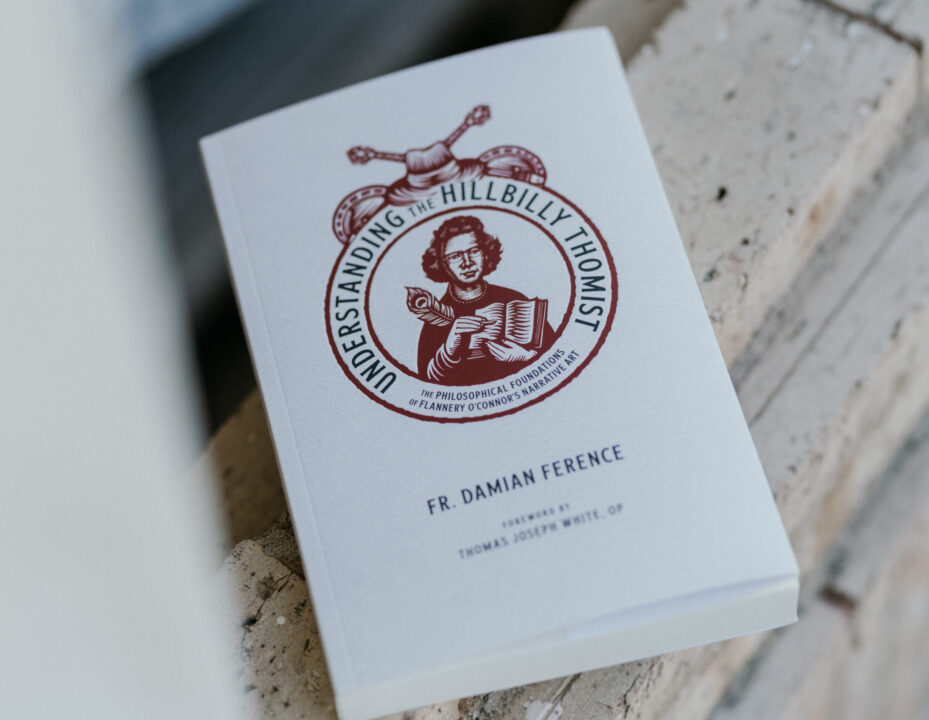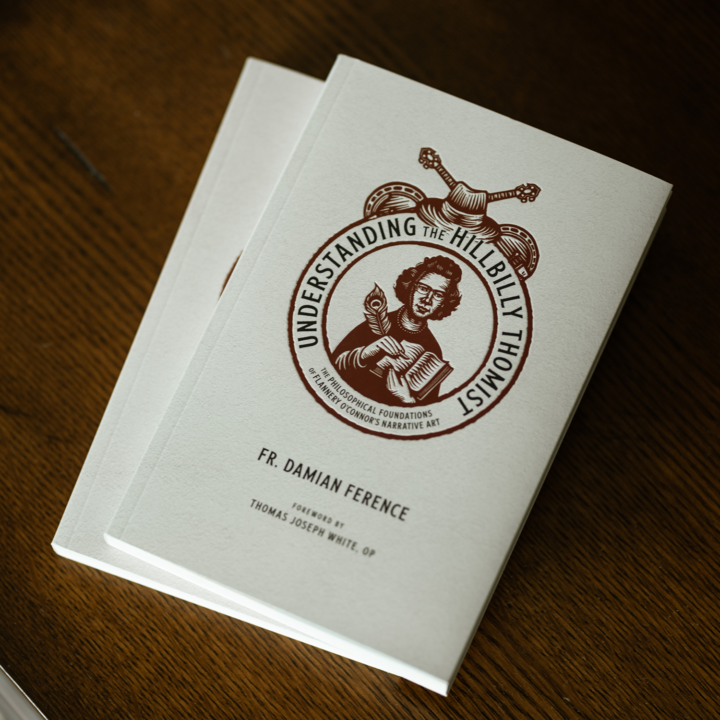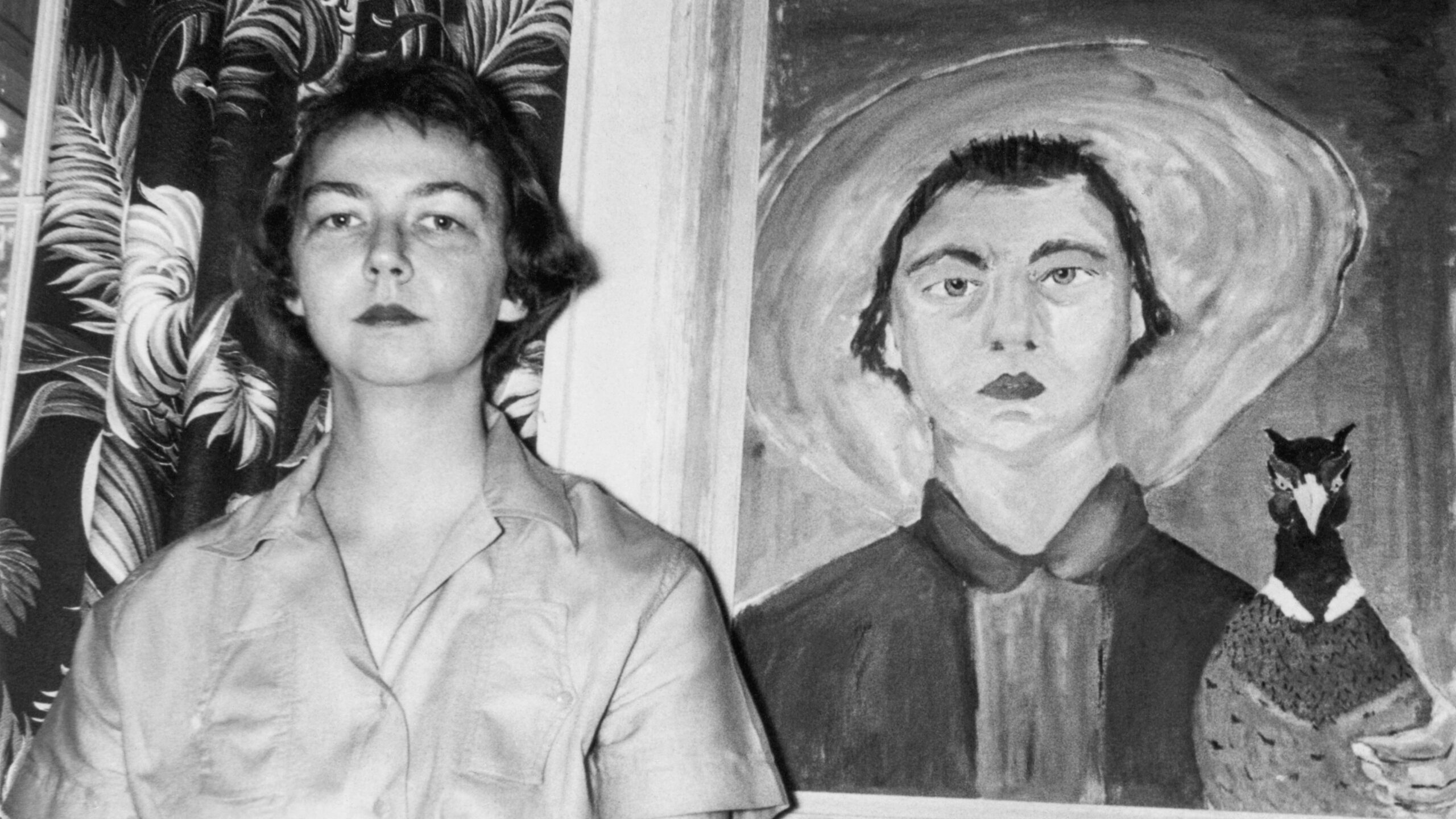The following is an excerpt from pp. 14-18 in Chapter One, “Foundations,” of Understanding the Hillbilly Thomist (Word on Fire Publishing) by Fr. Damian Ference.
The book decodes Flannery O’Connor’s narrative art, which originates in O’Connor’s own term: Hillbilly Thomism. Ference examines the various ways in which St. Thomas Aquinas and the philosophical tradition of Thomism shaped not only O’Connor’s view of reality but also the stories she told.

G.K. Chesterton, in his 1933 biography of St. Thomas, writes, “The Thomist philosophy is nearer than most philosophies to the mind of the man in the street.” Following Aristotle, Aquinas taught that human knowledge begins with the senses (principium nostrae cognitionis est a sensu), that the senses are trustworthy, and that they are the natural way for human beings to encounter the world. If we see that the sky is dark, feel drops of water falling on us, and hear thunder cracking, we know it is raining; there is no reason to be skeptical about that fact. From the earliest ages of human experience, we trust that our senses tell us the truth. Infants and toddlers are constantly looking at things, touching things, and tasting things (often things that are not edible) because this is the natural way that human beings come to know the world. From that foundation, Thomism also holds that the information provided by our senses is intelligible—able to be understood and to lead us to real knowledge. It takes no great exertion of mental will to encounter the world in this way—trusting our senses is natural and normative. What is forced and unnatural is the modern philosophical “twist” by which we might choose to doubt our senses—a choice that strikes the proverbial “man in the street” as absurd.
While O’Connor’s philosophy professor Dr. Beiswanger “took for granted that the Renaissance and the Age of Enlightenment set the Western mind free from the benightedness of Medieval thought (from Thomas Aquinas, etc.),” his student did not; on the contrary, Beiswanger remembers that O’Connor made it clear that “she didn’t believe a word I was saying.” O’Connor was more amenable to the perspective of Étienne Gilson, a leading voice in the Thomistic revival of the twentieth century. In The Unity of Philosophical Experience (which O’Connor called “indispensable to an understanding of the modern age”), Gilson methodically dissected how every modern attempt to reinvent philosophy in the image of other sciences had resulted only in the “loss of confidence in our ability to achieve philosophical truth” at all—that is, in deeper skepticism.
“Down-to-earth realism” is an excellent and appropriate description of Hillbilly Thomism . . .
René Descartes—the purported “hero” of Beiswanger’s course—began his philosophical method by doubting his own senses. Thomism resists this unnatural Cartesian twist, holding instead to what Gilson calls “the solid, down-to-earth realism of the classical metaphysics of being.” This reference to “down-to-earth realism” is an excellent and appropriate description of Hillbilly Thomism and likely would have appealed to O’Connor.
The Oxford Dictionary entry for “hillbilly” is as follows: “an unsophisticated country person, as associated originally with the remote regions of the Appalachians.” O’Connor’s use of the term “hillbilly” is not meant to be derogatory but does suggest that even country folk with no formal background in philosophy nevertheless reflect Thomistic epistemology: they use their common sense and trust that their senses are telling them the truth about reality. As Robert Sokolowski puts it, “There can be a hillbilly Thomist, but there could not be a hillbilly Kantian or Hegelian, let alone a hillbilly Derridean.” In other words, the insights of Aquinas “can be expressed in a simple, straightforward manner,” a manner that even a hillbilly would understand, but the same cannot be said of Kant, Hegel, and Derrida because their philosophies all reject the starting point of common sense.
Borrowing Chesterton’s language, we might take “Hillbilly Thomism” as another way of saying “man-in-the-street Thomism.” Perhaps this seems almost redundant—why not just say “Thomism”? But Chesterton goes on to lament that only rarely in practice is the common sense of Thomism expressed in a common manner. For the average person, untrained in philosophy, the difficulty of engaging with St. Thomas’ language (whether in Latin or in translation), combined with a lack of imagery to illustrate his logical method, constitutes “a very high brick wall” that unfortunately serves to separate “normal men” from “normal philosophy.” For most of us, overcoming the barrier requires the help of a great teacher—or perhaps a great artist. O’Connor managed, as did Dante, to climb the wall, see what was on both sides, and vividly illustrate for others the relationship between the two.
Knowledge begins in the senses, but it does not end there. Thomists are not mere empiricists, and a Thomistic novelist is not simply a journalist. In chapter 3, we will look closely at the Thomistic account of how human beings use their sensory powers to “abstract” the spiritual nature of things from their appearances and come to know universal truths not by disembodied reason but by observing particular truths in the world. When we emphasize that Flannery O’Connor trusted, both in philosophy and in art, the authority and intelligibility of her sensory powers, this is not a trivial point. The cultural consequences of modern philosophy we see in our own day, from the techno-futurist enthusiasm for a coming virtual “metaverse” to the rise of what Bishop Barron has called the “culture of self-invention,” demonstrate that not all human beings are—or want to be—in touch with this most human way of being in the world.
Neither is O’Connor’s exhortation that artists must “be humble in the face of what-is” an unremarkable or reliably conventional outlook, even among Catholics. In the culture of her time, she observed and frequently denounced a strong current of “vapid Catholicism,” a safe, sanitized abstraction of the faith that led to bad art filled with superstition and sentimental cliché. “When the Catholic novelist closes his own eyes and tries to see with the eyes of the Church,” O’Connor warned, “the result is another addition to that large body of pious trash for which we have so long been famous.”
O’Connor had no interest in turning out “pious trash” on behalf of an abstract idea (even if it was a good idea). She was concerned with recta ratio factibilium—“right reason in the order of making things”—beginning with the sensory data from the world, whether that data be pleasing, painful, or perverse; looking deeply, in order to know the invisible reality given initially through sense experience; and then, by careful artistic craft, drawing the reader into its beauty, power, and startling mystery. This approach—taking the world as she found it, then looking for the deeper reality it signified even in all its messiness and distortions—was not just Catholic but Thomistic, and she saw it as Thomistic.

Featuring an impressive array of biographical and literary evidence and extended analysis of her short stories “The River,” “Parker’s Back,” and “The Displaced Person,” Understanding the Hillbilly Thomist (Word on Fire Publishing) examines the intersection of medieval philosophy and modern fiction in the work of Flannery O’Connor, one of the most treasured artists of the American South.
You can get your own copy here.
